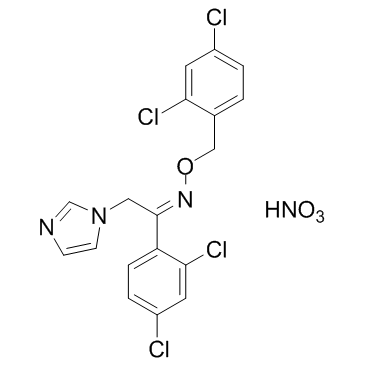64211-46-7
| Name | oxiconazole nitrate |
|---|---|
| Synonyms |
Ethanone, 1-(2,4-dichlorophenyl)-2-(1H-imidazol-1-yl)-, O-(2,4-dichlorophenyl)oxime, (1Z)-, nitrate (1:1)
MFCD00865580 Oxiconazole nitrate (1Z)-N-(2,4-Dichlorophenoxy)-1-(2,4-dichlorophenyl)-2-(1H-imidazol-1-yl)ethanimine nitrate (1:1) EINECS 264-730-3 (z)-1-(2-(2,4-dichlorophenyl)-2-(((2,4-dichlorophenyl)oxy)imino)ethyl)-1h-IMIDAZOLE mononitrate |
| Description | Oxiconazole nitrate is a broad spectrum antifungal which can inhibit the growth of T. tonsurans and T. rubrum with MIC90s of 0.25 and 0.5 μg/mL, respectively. |
|---|---|
| Related Catalog | |
| Target |
MIC90: 0.25 μg/mL (T. tonsurans), 0.5 μg/mL (T. rubrum)[1] |
| In Vitro | Oxiconazole nitrate is the more active compound in tests with T. tonsurans and T. rubrum. Twelve isolates are inhibited by 0.063 μg/mL of oxiconazole; corresponding econazole MICs range from 0.063 (three isolates) to 8 (two isolates) μg/mL. Three isolates have oxiconazole MICs of 16 or 32 μg/mL[1]. |
| In Vivo | The baseline distortion product otoacoustic emission (DPOAE) results of the right ears of all animals tested are normal. Animals in groups I, II, IV and V show no statistically significant change in the DPOAE amplitudes. The rats in the gentamicingroup show a significant decrease[2]. |
| Cell Assay | A total of 121 isolates of pathogenic fungi are tested. The three drugs (including Oxiconazole nitrate) are serially diluted in sterile saline. For each test plate, 2 mL of a solution of drug in sterile saline is added to an 18 mL blank of molten agar medium at 50°C and mixed well; the resulting mixtures are then poured into the plates and allowed to solidify. The resulting drug dilution sequences range from 128 to 0.063 μg/mL. Control plates are prepared in a similar manner using 2 mL blanks of sterile saline. The plates are then inoculated using a replicator. Incubation is at 30°C for a minimum of 96 hr. The Minimal Inhibitory Concentration (MIC) is defined as the lowest concentration of drug producing complete inhibition of growth[1]. |
| Animal Admin | Fifty adult rats are divided into 5 groups consisting of 10 animals each. Over 14 days, the rats in group I receive 0.1 mL of Oxiconazole nitrate-containing solution drops, group II receives 4% boric acid solution in alcohol drops, and groups III and IV receive gentamicin (40 mg/mL) and saline solutions, respectively. Group V receives no medication. Each solution used is given twice a day[2]. |
| References |
| Boiling Point | 576.8ºC |
|---|---|
| Melting Point | 137-1380C |
| Molecular Formula | C18H14Cl4N4O4 |
| Molecular Weight | 492.14 |
| Flash Point | 302.6ºC |
| PSA | 105.46000 |
| LogP | 6.15550 |
| Storage condition | Refrigerator |
CHEMICAL IDENTIFICATION
HEALTH HAZARD DATAACUTE TOXICITY DATA
|
| Hazard Codes | Xi |
|---|---|
| Risk Phrases | R36/37/38:Irritating to eyes, respiratory system and skin . |
| Safety Phrases | 37/39-26-36 |
| RIDADR | NONH for all modes of transport |
| WGK Germany | 2 |
| RTECS | CQ7700000 |
| HS Code | 29335995 |
| HS Code | 29335995 |
|---|
